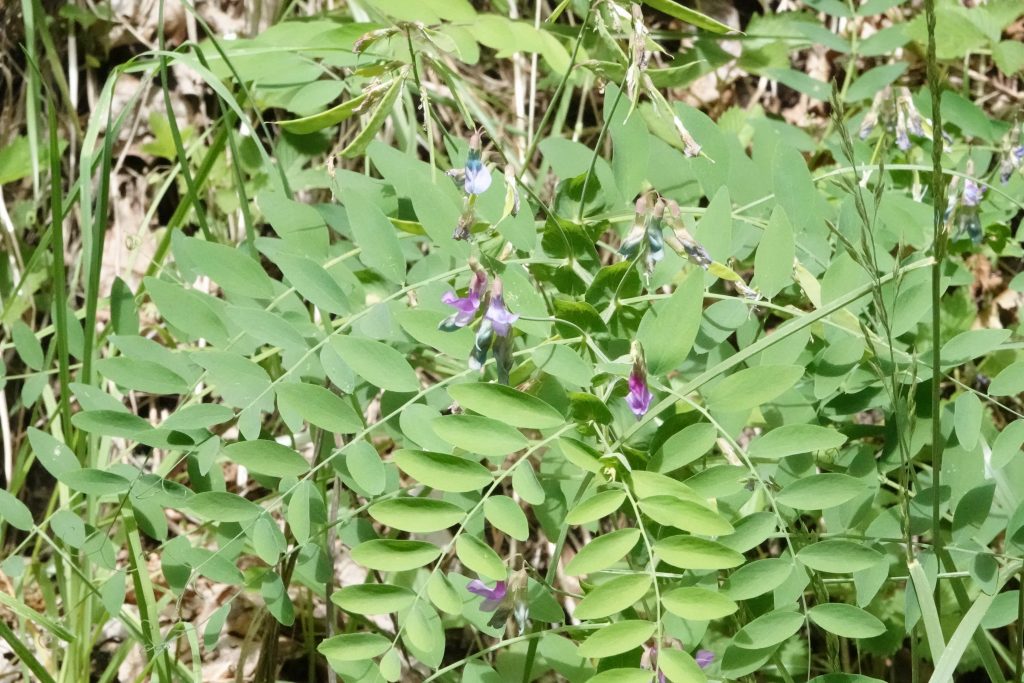
When I ran into a fairly large patch of this whilst wandering along the road above Canyon Creek after I gave up on fishing on opening day, I decided that the time had come to figure out for sure whether I was looking at Lathyrus polyphyllus (which also goes by the common names Oregon pea and leafy pea) or L. nevadensis. I had gotten hung up on the idea that the difference between them was that L. polyphyllus had purple to blue flowers, and L. nevadensis had purple to reddish pink flowers, and those are distinctions my lack of certain cones in my eyes will simply not allow me to make.

But it turns out to be much simpler than that. When I drove back up to Canyon Creek on Tuesday afternoon, preparatory to doing a night of mothing, I took ‘Flora of the Pacific Northwest’ with me, along with a hand lens and a three legged stool. And in just a couple minutes I had positively determined that those plants were Lathyrus polyphyllus, because not only were there more than 10 leaflets per stem (and seemed to mostly have 12), whereas L. nevadensis has from 4-10, but the tendrils at the end of each rachis were clearly branched, and L. nevadensis has simple, unbranched tendrils. It was so simple, once I decided to make the effort. And I didn’t even need the hand lens, although the stool was sure nice. And I just noticed, while choosing photos for this profile, that most of them had all the information I needed to differentiate between the two superficially similar species.

Ethnobotany– I can find no ethnobotanical usages for this plant.
Description– “Vine with tangled stems, many leaves. Plant hairless. Stem angled but not winged. Leaves with stipules at the base as big as leaflets, tendril at end of leaf branched, coiled or very short. Leaflets 10–16, oval, 1–2 1/2 in. long. Inflorescence on leafy stalk, more or less 1-sided with 6–12 flowers. Flowers purple, fading to blue.” Lathyrus polyphyllus | Leafy Peavine | Wildflowers of the Pacific Northwest

Similar species– Lathyrus japonicus has strongly arrowhead shaped stipules; L. brownii and L. pauciflorus have wings of flowers noticeably longer than their keels; L. palustris and L. delnorticushave distinctly winged stems; other Lathyrus have much smaller stipules, or fewer leaflets, or unbranched tendrils, or have yellow flowers.

Habitat– Coniferous forest openings up to mid elevation.
Range– Found only in the PNW; primarily west of the Cascades in Washington and Oregon, as well as sw Oregon/nw Washington; may be disjunct populations in the southern Wallowas and foothills of the western Rockies.

Eaten by– Larval host of Cupido amyntula (western tailed blue) and possibly Plebejus idas(northern blue); nectar source for Papilio rutulus (Western Tiger Swallowtails) ; Oddly, I can find nothing else specific to this plant, but undoubtedly browsing mammals like deer and rabbits must eat the foliage, and there are probably legume loving leaf mining flies and other lepidoptera that use it as a larval host.

Reproductive timing– Flowers bloom from April to July, depending on elevation and latitude.
Etymology of names– Lathyrus is from the Greek word for legumes. The specific epithet polyphyllus is from the Greek words for ‘many leaved’, appropriate since this is one of the leafier of our native Lathyrus, with 10-16 leaflets per stem.

OregonFlora Lathyrus polyphyllus
Lathyrus polyphyllus | Leafy Peavine | Wildflowers of the Pacific Northwest
Leafy Pea, Lathyrus polyphyllus
Lathyrus polyphyllus – Burke Herbarium Image Collection

Nicely done! Lots of useful details, clear and useful images. Thank you!
Thank you for your appreciation, Janet!
Grows in northern MN as well! My patch is on a steep bluff surrounded be mature pines Deer and rabbits won’t eat them!